The Fossil Folly
The Truth About America’s Addiction
While consumers defend their addiction to driving, automakers defend their addiction to old internal combustion technology and utilities defend their addiction to fossil fuels, we all must find a real solution to volatile energy prices, air pollution and global warming before we too become like the dinosaurs – extinct.
The fossil folly began in 1885 when coal replaced wood as a heating fuel. Fuel usage escalated for the next fifty years as humankind learned to produce petroleum and natural gas. In the 1920s internal combustion technology from World War I started rapidly replacing mammal muscle-powered machines, lighting up America’s addiction to energy. From 1950 to 2006, the U.S. population doubled, and at the same time, energy usage tripled.
Today, U.S. citizens are some of the largest energy addicts in the world, second only to China per capita. However, i is important to keep in mind the sheer volume of manufactured goods imported from China that U.S. citizens underpin by their spending habits. In essence, the energy consumption (and pollution) from China is largely funded by American citizens, government and businesses through ongoing procurement decisions.
The Amount of Fossil Fuels We Consume is Staggering!
Fossil Fuels dominate the landscape of energy use in the United States.
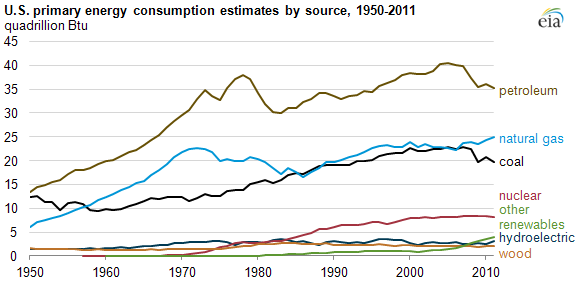
US citizens annually consume (burn) over:
- 5.1 billion barrels of oil for transportation plus 1.9 billion barrels burned in old power plants, poured on highways and rooftops as asphalt or made into other products. 2,550 supertankers of oil every year!
- 22.5 trillion cubic feet of natural gas (68% to heat buildings, 30% to power gen). 111 million Goodyear blimps worth of natural gas every year!
- 1 billion tons of coal (91% in power plants). That’s roughly 40 billion cubic feet or 3,420′ x 3,420′ x 3,420′. An entire mountain of coal every year!
With the uptick in domestic natural gas production, coal use has decreased somewhat. However, with global demand increasing total fossil fuel consumption is still projected to rise. Worse yet, if cleaner burning domestic natural gas exports increase, gas prices will go up and dirty coal consumption will again rise to match the demand.
Local Addiction – Global Nightmare
In 2006, the U.S. generated over 2,700,000 MWh of electricity from its 10,800 fossil-fueled power plants emitting more than 3.7 million metric tons of smog producing NOx, 9.5 million tons of acid rain causing SO2 and 2.4 billion tons of CO2 greenhouse gases.[i] Putting that in perspective, the US only has 5% of the world’s population, but emits 25% of the world’s air pollution. If we continue with business as usual, U.S. energy use will escalate at least 1 percent per year through 2030, while worldwide energy use will escalate at 2% percent. Developing countries are following our fossil path, not charting a sustainable path. Atmospheric CO2 concentrations will continue to double from pre-industrial levels to 560 ppm before 2050. Dubiously enough, we are right on track to breach that threshold sooner! This doubling is expected to cause an overall 1.8 – 5.4 degree Fahrenheit rise in global average temperatures by 2050.

While this may seem small, these minute changes will cause drastic changes in rainfall patterns and continue the rapid melting of glaciers across the planet. This will cause extreme weather conditions and sea levels to rise, resulting in flooding. This will destroy delicate ecosystems and cause a sharp decline in mankind’s food supply. Unfortunately, all you have to do is read any nature journal or science digest or get outdoors to see vegetation and animals dying off and becoming extinct at an alarming rate. As a major contributor to global energy-related air pollution and stewards of the wonderful natural resources we have been given, we have the obligation to lead the world into a sustainable future. We simply cannot bury our heads in the sand and “hope for the best”.
So Where Does It All Go?
Even though 3/4 of all oil consumption is for internal combustion engines in cars and trucks, it’s only a fraction (29%) of total energy consumed in the U.S.[vi] Roughly 39% goes to feed our inefficient building stock – primarily just to heat or cool the air a few degrees or add light to a room, most often while it’s already light outside. The remaining thirty-two per cent (32%) is used in industrial processes (for producing, processing and assembling goods).
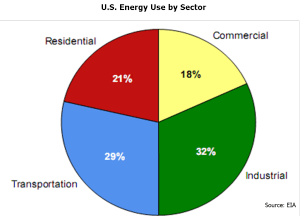
Worse yet, only 19% of the fossil fuels we buy result in actual productive energy use or work. According to the EIA, “two-thirds (approximately 67%) of total energy input (for power generation) is lost in conversion” and “of electricity generated, approximately 5% is lost in plant use and 9% is lost in transmission and distribution.” Consider the present model for heating and cooling most buildings. First, we drill a hole in the ground, pump gas or oil hundreds of miles to a power plant, and then burn the fuel in a boiler or furnace to heat water to 600 – 1000 degrees F to spin steam turbine blades. The turbine is connected to a generator which then makes electricity. We then send the electricity over hundreds or thousands of miles of power lines connected to our buildings to heat wires to warm the air or run air conditioning compressors. The air conditioner then cools a fluid so we can run that over a coil to simply heat or cool the air in our room by a few degrees. Pretty inefficient isn’t it?
Clearly, we must shift our investments from this grossly inefficient architecture to more efficient non-polluting architecture. Fortunately there are many options for both consumers and utilities to become more efficient and non-polluting.
Clean Energy Options Abound:
Fortunately, the fossil folly can be rectified. But with so much resistance to change, it requires everyone (in the global supply chain) to do their part. Following is an overview of several clean energy options followed by a roadmap for: consumers, business, utilities and policy makers to follow. If followed, this roadmap will allow the United States to transition to a diversified, clean energy portfolio and put an end to our global fossil fuel problems.
Energy Efficiency
Energy efficiency is the low hanging fruit to reduce our dependence on fossil fuels. Energy use in (residential, commercial, and industrial) buildings accounts for two-thirds of the nation’s total energy use.
While most people think of energy efficiency as buying an Energy Star refrigerator or copier, this false sense of efficiency only serves to reward status quo design and planning. It’s the design of our infrastructure that is grossly inefficient. Replacing components will only slow down the inevitable and never fix the root cause of our energy addiction. Our approach to designing and retrofitting buildings needs to be rethought so we can remove our dependence on unnecessary mechanical systems and utilize natural laws of physics, such as heat transfer, to provide comfort. For example, we must design high efficiency buildings that first rely on thermal efficiency and natural ventilation with passive heating and cooling to provide comfort. Windows, clerestories and light tubes, for example, bring in natural daylight. Building integrated solar power can provide the small balance of electricity needed for computers or process loads. Our water and wastewater systems must also be organic and avoid the need for complex wastewater treatment plants and massive water conveyance or public works infrastructure.
To do this, architectural design considerations must include the building site, orientation of the building, use of reused and recycled building material, the placement of windows, etc. Engineering (whole building) design considerations must include building modeling, natural ventilation, passive heating and cooling, energy efficient mechanical and electrical equipment selection, evaluation of clean/renewable energy solutions, and design methods to minimize water use through efficient fixtures and/or reuse of water and/or capture of rainwater. Incorporating campus or district master planning provides additional opportunities to improve efficiency via capture and reuse of wasted heating and cooling energy and water waste.
Sustainable design and construction provides a foundation for building sustainably. The United States Green Building Council (USGBC) encourages sustainable design through the Leadership in Energy and Environmental Design (LEED) Green Building Rating System. LEED “is the nationally accepted benchmark for the design and construction of high-performance green buildings,” providing business owners and operators with the tools they need to significantly improve their buildings’ performance.[vii] Building owners can be assured of building performance and comfort with EPA Energy Star certification. We cannot stop there though. Building owners must demand continuous measurement and commissioning processes to ensure inefficiencies in the original building design are corrected and even improved upon to ensure the building is always operated at peak performance.
So, how do you ensure that you have an energy efficient building? Anyone who builds a new home or business and/or owns an existing building should seek advice from architects, engineers and consultants who specialize in this area. Unlike conventional architects and HVAC designers who typically design to meet code thresholds, these energy and environment professionals are familiar with optimal solutions and can better navigate, educate and challenge codes and uninformed building officials while capitalizing on federal, state and regional transitional incentive programs that will help make “going green” a cost-effective solution for early adopters.
As energy prices escalate, the Whole Building, Campus or District Design approach to energy efficiency will become the de-facto standard due its inherent cost effectiveness for consumers. To promote this transition, it is essential that consumers demand more efficient performance-based designs and technologies from planners, architects, engineers, builders and manufacturers. Consumer demand for these services and products is essential to force a shift to exclusively using high efficiency building designs and products throughout the nation.
Adaptive Smart Grid and Demand Management
Demand management is a tool used by utilities to help them levelize power production and provide grid stability. On the average day, the demand for energy varies significantly. Daily power demand generally looks like a tall bell-shaped curve, peaking during the middle of the day (when people are at work and air conditioning units are humming) then dropping off throughout the night (when the weather cools down and most people are sleeping). Since large power stations are often slow to start up and expensive to idle, power demand needs to be well managed to avoid large fluctuations that can cause instability or blackouts on the power grid. Overloading a single power line can generate excess heat, cause the line to sag or break and result in power-supply instability (phase and voltage fluctuations) that can ripple throughout the grid.
Demand management helps smooth power fluctuations by temporarily shedding user’s peak loads during extreme demand days, such as a heat wave, and flattens the bell shaped curve by temporarily eliminating or shifting peak loads to off peak periods. Utilities accomplish demand management in two ways: by using a “carrot” or a “stick”. The “carrot” gives incentives to companies who participate in a demand management program (a.k.a. a temporary load shedding program), where the consumer or business temporarily turns off or trims back their major power consuming equipment, reducing the demand on the grid and making the transmission infrastructure more stable. The business generally agrees to shut off equipment for 2-3 hours. The stick method to demand management occurs when the utility has critical peak or real time pricing programs where power costs are extremely high (5 to 10 times higher) during high demand periods. This forces businesses to reduce their power usage during peak demand times unless they want to be charged the very high price for power.
Unfortunately, demand management alone may not relieve power congestion and blackouts. The Department of Energy (DOE), Federal Energy Regulation Commission (FERC) and other utility organizations including the Electric Power Research Institute and the Edison Electric Institute believe the “answer is to change the grid physically” by expanding “capacity so controllers can switch energy from line to line without overloading.”[viii] This is not an easy task though. Developers must foresee the capacity that will be needed in the future to ensure grid stability lasts as well as make certain that renewable technologies and distributed generation can be readily integrated into smarter utility transmission grids or micro-grids. Development of new transmission lines is also capital-intensive and is usually controversial because environmentalists are unsupportive of increased development on undeveloped lands. This debate leaves demand management mechanisms as the only near-term method of ensuring grid stability as power demand continues to grow.
An alternative to additional infrastructure is the development of a smarter power grid. A Smart Grid is essentially a computerized electrical power industry, from power plant to office or home appliance. To make this work, software would be installed at large power plants to optimize energy production as well as on home appliances, such as air conditioners, to manage energy use. If Smart Grid software were installed on the majority of energy consuming equipment nationwide, equipment operation would be optimized and energy use would be reduced, saving consumers money, all while helping to stabilize the utility grid and reduce the need for additional transmission infrastructure. Studies indicate the average household would save 10% in energy costs annually. Implementation of a Smart Grid warrants significant research and consideration by utilities since it reduces the need for new infrastructure via enhanced power management and energy efficiency. It is important to keep in mind that a distributed generation architecture will be inherently more efficient and secure than central generation since transmission and distribution inefficiencies and bottlenecks will be avoided.
Solar Power
Solar energy is free, reliable, and very abundant. It is a source of energy that has sustained plants and animals for millions of years and is one of the primary solutions to sustain our energy-hungry way of life.
While solar radiation varies with atmospheric conditions, the position of the earth, and other atmospheric influences, the potential of harnessing solar energy in the U.S. is essentially limitless. This was first realized during the oil crisis in the 1970’s. At this time, photovoltaic PV panels were not very efficient and not discounted or subsidized like fossil fuels, so installation was limited. Thankfully, recent advances in design, materials, and manufacturing have helped improve solar installation feasibility. From 2005 to 2006, U.S. PV installation increased by 33 percent and continues today. This significant increase in capacity was possible because of the 30 percent federal tax credits (that U.S. oil production has enjoyed for years), limited state tax credits, state rebates and utility net metering opportunities. One existing problem limiting solar power from reaching grid parity in cost with fossil fueled power is the fact that fossil fueled power does not include the complete costs of pollution and healthcare. According to a study written by H.M. Hubbard in 1991, the estimated societal costs of increased health care expenditures, environmental degradation, and lost employment due to emissions range from $100 – $300 billion per year. While this 1991 study is dated, it shows that hidden costs associated with fossil fuel use are substantial. A more recent 2006 air quality impact study conducted in the San Joaquin Valley, California determined that the cost of air pollution averages $1,000 per person per year. The results include the costs of health problems, premature deaths, missed schools days, and decreased worker productivity that result from air pollution in the region.[ix] Assuming this cost per capita was consistent across the U.S., annual cost for air-quality related health-care is over $300 billion. Including these hidden costs into the price of fossil fuels will allow for more accurate comparisons to alternative fuels such as renewable energy. Luckily, some state policy makers, like in California, are beginning to grasp this concept and are incentivizing clean energy to protect public health. Governments worldwide must continue this trend so the open markets can act on it.
While solar power is fairly reliable in most southwestern states, it is not yet as reliable as utility power generators are accustomed to with fossil fueled power plants. Solar energy production follows a curve during the day. Production peaks in the middle of the day when the sun is at its peak. Inclement weather (clouds) reduces production and nighttime stops production. The map below shows solar radiation throughout the U.S. The southwest has very high solar potential, diminishing towards the northwest and northeast.[x] Compared to Germany and Spain, even Alaska has more than ample solar capacity!

In recent years, technological advancements of solar resources have proven to be a promising technology to help diversify America’s energy portfolio. The three primary technologies available today include PV, solar thermal, and concentrating solar power (CSP).
Wind Power
Wind power is also free, reliable, and very abundant. Wind is a great teammate for solar power as it generally peaks when solar fades. Night time and periods of inclement weather generally create high wind conditions, perfect for spinning turbine blades. As of 2011, installed wind capacity in the U.S. is over 12,600 MW. However, this is still less than 1% of total U.S. electricity generation. As shown on the wind map below, the central U.S. as well as many of the coastal and mountain regions have medium to high winds and thus are good wind development areas.[xi].
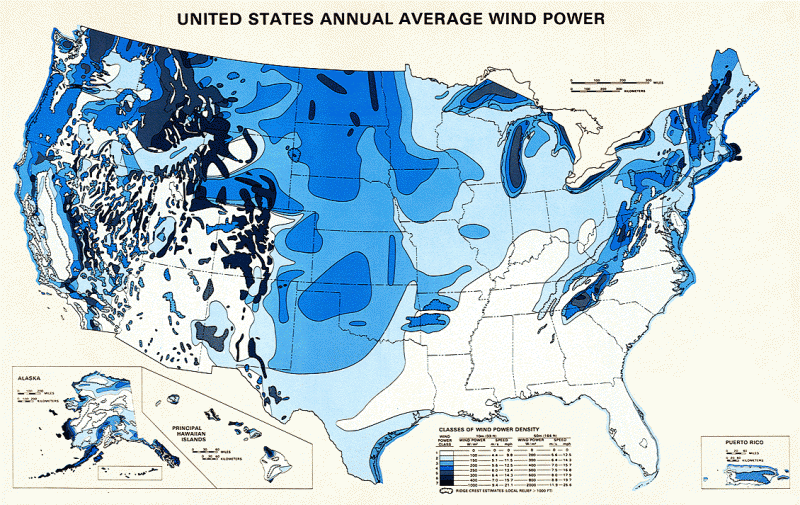
Offshore wind potential is also plentiful. According to the DOE, U.S. offshore wind capacity (potential) is projected to be 900 GW or 91% of total U.S. summer power demand in 2006.[xii] Offshore wind farms are attractive because of the higher speed, smoother, less turbulent winds and ample open space. In addition, larger turbines can be installed offshore in these high wind areas. Large turbines are more economical, and produce significantly more energy than smaller turbines (wind energy is a function of turbine size and energy is proportional to the cube of the wind speed). However, not unlike oil rigs, installation costs for installing wind turbines offshore can more than double installation costs.
When compared to traditional fossil fuel plants, onshore wind power can be challenging because winds are intermittent. In other words, the supply of wind power to the grid varies with the wind resulting in fluctuations on the grid that can cause instabilities in the transmission infrastructure. There are two methods to solve this problem: grid upgrades and storage. Grid updates would help reduce the vulnerability to the grid by providing a more demand fluctuation tolerant transmission grid. As mentioned in the demand management section, this is a costly solution. The second option is wind storage. At a wind farm with wind storage, power produced by the turbines would be supplied to the transmission grid. If the grid was nearing maximum transmission capacity, the electricity produced by the wind would be routed to a storage system where the electricity would be used to store electrons, create compressed air or some other potential energy. When the grid needed additional power that the turbines could not supply, the stored potential energy would be released to produce electricity for the grid. Until wind power becomes more reliable or storage becomes more economical, grid managers will continue to hesitate to promote a high percentage of wind power in their portfolios until one of these options is commercially competitive.
Nuclear Power
Nuclear power plants produce hundreds of times more power than a comparable fossil fueled plant. Since the Chernobyl, Russia accident and misleading panacea from the movie Silkwood, growth of nuclear power in the U.S. stopped. The Chernobyl power plant, a graphite moderated reactor, was a completely different (and inferior) design than any U.S plant (pressurized and boiling water reactors) in existence. Moreover, the Chernobyl accident was a result of operator errors and testing with many fail-safes overridden. As such, the U.S (and most of the world’s) power plants could no longer have this type of error. Granted, concerns still exist, with long-term radioactive fuel storage as the major controversial issue. The new generation of “breeder” reactors and power plants are far safer and have much less waste. More importantly, they are far cleaner and easier to monitor than the thousands of fossil-fueled power plants spread across the U.S and China. Without efficiency improvements, it would take 385 additional nuclear plants to displace the thousands of air polluting fossil fuel plants in the US. If we electrified all our transportation in the US, we would need only 253 more nuclear plants. In other words, a total of 742 nuclear plants would be required to completely offset all fossil fuel use in the U.S.
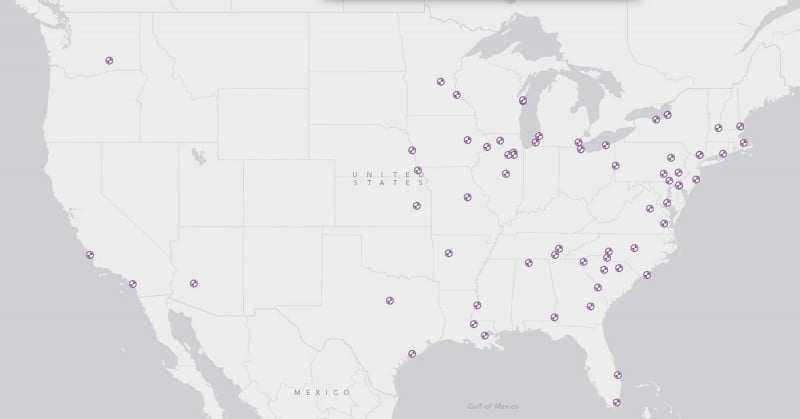
Carbon Capture and Sequestration
Carbon capture and sequestration (CCS) is an emission mitigation mechanism. In other words, it is a retrofit option for fossil burning power plants. CCS refers to the capture of carbon dioxide (CO2) from large emission point sources and the long-term storage of that CO2 in the ocean or underground geological reservoirs. The objective of CCS is to slow the increase of anthropogenic CO2 in the atmosphere.
There are four steps to CCS: carbon capture, carbon transport, carbon sequestration, and carbon storage. Carbon capture is the first step. It requires CO2 to be separated and captured from the flue gas of large emission point sources, such as coal and natural gas power plants. Carbon capture is not a new technology. Currently, CO2 is separated in processes such as synthetic ammonia production and limestone calcinations. However, the carbon separation and capture process is expensive and varies greatly depending on the technology used. For example, according to the 2005 International Panel on Climate Change (IPCC) report, electricity produced at a conventional pulverized coal plant costs $0.04-$0.05/kWh. With carbon capture and geological storage, current cost range is $0.06-$0.10/kWh.[xiv] Note: The cost of fuel has increased since 2005, so these prices do not reflect current prices. Nevertheless, the cost difference between a conventional coal plant and the cost of carbon capture and sequestration is illustrated. More economical capture technologies, such as absorption (chemical and physical), adsorption (physical and chemical), and low-temperature distillation are being investigated. [xv]
Once captured, the CO2 must be transported (e.g. via pipeline) to a location where it can be stored. Possible storage locations for captured CO2 include the ocean and geological formations. The ocean is a natural carbon sink, so scientists are researching its potential to be an anthropogenic CO2 sink. Two different methods of carbon sequestration in the ocean are being considered: 1) enhance the ocean’s uptake of CO2 from the ocean via enhancing the fertilization of phytoplankton and 2) inject pure CO2 into the deep ocean. Research about carbon sequestration in the oceans is at an early stage; therefore, many questions still have to be answered. For example, what are the consequences of long-term ocean fertilization, how will CO2 effect sea habitats, is CO2 injection into the ocean effective for long-term storage, will the CO2 effect the acidity of the ocean permanently? International and national legal and regulatory problems will also arise with CO2 disposal into the ocean due to off-shore disposal legislation and national borders. [xvi]
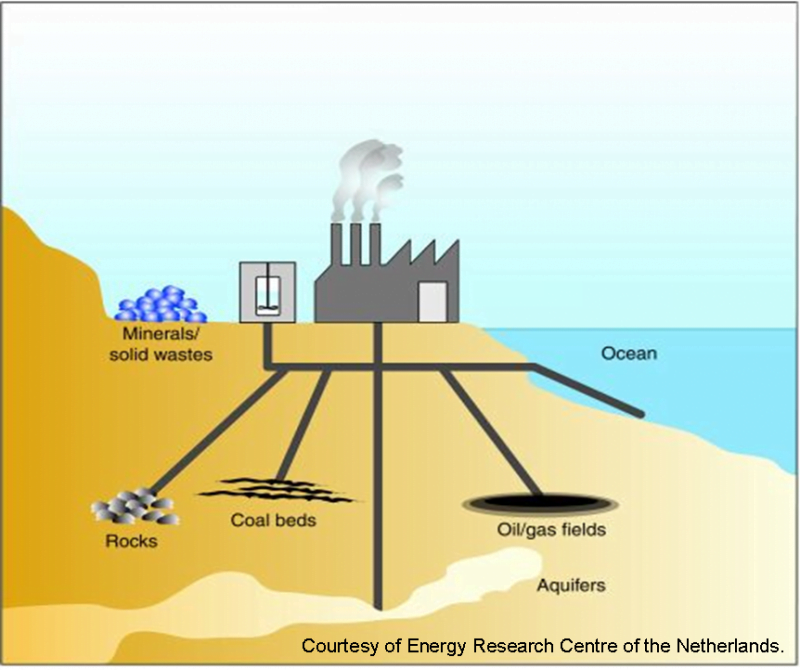
The most probable option is carbon sequestration in geological reservoirs. Injection of CO2 in geological reservoirs is a proven and available technology; it is called Enhanced Oil Recovery (EOR). For EOR, CO2 is injected into oil reservoirs to improve the oil flow rates during secondary and tertiary stages of production. Several commercially viable projects for enhanced oil recovery have been operating throughout the U.S. for many years; however, the injected CO2 was never expected to permanently remain in the reservoir. Scientists are researching methods to ensure the injected CO2 remains in the reservoir permanently. The International Panel on Climate Change believes it is a promising technology, estimating that well-planned and managed storage size could retain over 99% of the injected CO2 for millions of years. Further, estimated storage capacity of CO2 in the depleted oil and gas reservoirs and other formations (coal beds and saline formations) in the U.S alone is over 140 billion metric tons of CO2, providing storage space for 23 years at current emission rates (6,000 million metric tons per year).[xvii] With renewable energies taking years to develop, it is important that CCS, a commercially available technology, be implemented to help reduce current emissions and mitigate global warming until the fossil fuels are replaced.
Cost – The Final Frontier
By current metrics, renewable energy costs appear to be higher than fossil fuels. However, this paradigm is changing rapidly. With continued investment in clean energy technologies, costs are declining rapidly. Meanwhile, fossil fuel costs continue to rise with population and demand while available resources have arguably peaked. Furthermore, current cost metrics do not even include tax credits and hidden costs of burning fossil fuels (public healthcare costs).
First, the petrol industry currently receives a 30% Investment Tax Credit as well as a $0.01/kWh Production Tax Credit in the U.S. Is it necessary for a well funded, highly profitable, mature industry to receive incentives? Second, fossil fuel related health care costs are not accounted for in supply pricing. In 2002, the estimated Gross Annual Damage from air pollution was estimated to be between $75-$280 billion, or (0.7-2.8 percent of the Gross Domestic Product). It’s likely much higher now!
To look at it another way, this is equivalent to every US citizen paying between $250-$830 per year just to monitor and abate fossil fuel air pollution. This doesn’t even include the personal health care costs to fight calamities such as cancer and asthma. Clearly we must advocate that Federal Tax Accounting methodologies be modified to include air quality district fees with source (fossil fuel) pollution. Without this, “grid parity” for renewables is actually lower in cost than fossil fuels. Third, compensate clean energy producers fairly. Today, most building owners can put solar panels on their buildings and get paid below market price for the energy use they offset, but not a penny more. This is called net metering. A compensation structure that needs more serious consideration is adoption of feed-in tariffs similar to those adopted in Germany and other countries. This enables building owners and home-owners to use those roof spaces that can supply more energy than they may directly use and sell the remainder to the local grid for use by those who need it thereby reducing transmission losses and reducing security risks from a transfer station being blown up or a transmission line causing a fire. More importantly, this method provides local energy where it is needed most, such as cities and suburban centers, thus avoiding the need for costly new power plants and transmission lines. Transitioning from a dirty energy economy to a clean energy economy will require additional stimulus. The following actions will aid a smooth transition from dirty to clean energy.
- Eliminate federal tax credits and incentives for fossil fuels such as oil and natural gas.
- Shift air monitoring costs and an appropriate portion of public healthcare costs directly to the producers, such as power generators and gas stations, so they can pass it along in the true cost of the goods (instead of an unfair tax to all).
- Legislate feed-in tariffs for clean energy, at least until it displaces fossil fuels as our primary supply of energy. In other words, fossil fuels should be a backup of last resort or “alternative”, not the other way around.
The table below is a projected comparison of fossil fuel sources adjusted to account for fossil fuel tax credits and air pollution costs and full pay for energy and power production.
What Should Consumers and Businesses do?
Consumers today have more choices than ever. Competition brings new and advanced technologies that were never before available. The cheapest energy source currently available is conservation and efficiency. Beyond those two options, consumers can control their own energy destiny by maximizing their building space with on site solar energy and wind power and/or purchasing only clean energy or demanding clean energy policies (as illustrated later in this document). Finally, our driving habits as well as our transportation choices have a dramatic impact on costs and the environment. Here’s what consumers should do: focus on tune-ups and energy efficiency improvements, integrate clean energy (such as solar power and solar thermal) and change our transportation habits and investments. Remember, if you demand it, someone will step up to supply it.
Energy Efficiency
Optimal efficiency starts with the architecture. Homeowners and businesses should demand building’s that utilize passive (heating and cooling) design techniques to reduce or even eliminate heating and air conditioning systems. This will inherently improve comfort and reduce the size of heating and air conditioning systems which lowers first costs as well as long term utility costs. Other improvements include planting summer shade trees, boosting attic or roof insulation, adding ceiling exhaust vents to keep the attic cool in the summer and adding a whole house fan to flush the hot air out from a hot unoccupied day or low horsepower, slow spinning, long blade recirculating fans to temper already conditioned air.
Since heat rises, under floor heating and above ceiling hydronic cooling is a cost effective alternative to conventional all air HVAC systems. This eliminates the need for mechanical fans and leaky, dirt accumulating ductwork while improving comfort and reducing the need for humidification to offset dry air effects. Below grade air supply ducts, ground source heat pumps and hybrid solar absorption heating and cooling systems offer optional efficiency improvements. When mechanical heating systems are used, they should always be controlled by programmable thermostats or an energy management system that drops temperatures as low as possible during the winter and set back even lower at night and off when unoccupied. Cooling should follow the same concept: set as high as possible in the summer, set up even higher at night and off when unoccupied. Remember, comfort is largely defined by the difference in temperature between outside and inside and need not be an absolute 68 or 78 F.
Lighting can easily be improved by replacing incandescent lamps (bulbs) with long lasting super efficient light emitting diodes (LEDs). Appliances can be improved by purchasing Energy Star Rated products to lower electric consumption.
Solar Power
A technology that needs to become more widespread with architects, engineers and builders is Building Integrated Photovoltaics (BIPV). Integrating PV into the building enables replacement of roofs, windows and facades with components that also generate electricity and often function better. This design approach, along with energy efficient design, is the major impetus of architecture2030.org. Architecture 2030 is a non-profit, non-partisan and independent organization whose goal is to “achieve a dramatic reduction in the global-warming-causing greenhouse gas (GHG) emissions of the Building Sector by changing the way buildings and developments are planned, designed and constructed.”[xviii]
Rooftop PV and BIPV can be either stand-alone or grid-tied. Grid-tied systems feed the electricity produced by solar panels to the grid. If more solar energy is produced than what is needed by the building, the excess electricity is sent down the line to the next building that needs electricity. Buildings that generate electricity and are grid-tied are typically on a net energy metering (NEM) rate tariff with the local utility. NEM customers are allowed to subtract the energy (kWh) produced by solar from their utility bill. Unfortunately, the majority of these rate tariffs do not allow the customer to get paid for excess solar production or available power (kW demand). Hopefully this will change as policymakers and regulators recognize the long term benefits of clean power and incentivize the market to accept it.
Solar Thermal
Solar thermal technologies also provide a clean, energy savings opportunity. This technology uses the sun’s radiant energy to produce heat. The heat can be used to passively heat or cool a space or actively produce power, heat water (or almost any fluid) and even provide cooling through absorption systems.
Both PV and solar thermal are attractive technologies for homes and businesses since systems can be mounted on or near the buildings. Point source generation minimizes transmission and distribution requirements as well as line losses. Rooftop mounting is further advantageous because of space and sunlight availability. According to a study by the National Renewable Energy Laboratory (NREL), the low estimate of PV rooftop potential is 900 – 1,500 terawatt-hours (TWh) annually, equivalent to 25% – 40% of total U.S. electricity consumption in 2004.[1],[xix] Today’s U.S. net installed solar capacity accounts for only 1 percent of the nation’s total electricity usage. Potential for further development is certainly significant!
Transportation
As mentioned above, approximately one quarter of U.S. energy consumption is from the transportation sector. Therefore, reducing vehicle fuel consumption will mitigate energy use and associated environmental damage. Americans are accustomed to traveling in single-occupancy vehicles to and from work. We like this luxury; however, it is essential we change our ways of thinking. Methods include: improving environmentally friendly modes of transport, enhancing mass transit infrastructure, ride sharing, cycling paths, and sidewalks in and around cities. To encourage this, cities must set goals for developing sustainable transportation practices and annually evaluate their progress on sustainable transportation projects. In addition, public awareness about the consequences of different transport modes on energy consumption and climate change is necessary. Businesses can help reduce transportation energy consumption by allowing employees to telecommute and/or work four ten hour days for example.
Eliminating single-occupant vehicles is not likely in the near term; therefore, low GHG, high efficiency vehicles are also necessary. Fortunately, hybrid vehicles, plug-in hybrids and electric vehicles are expanding, thanks in most part to California’s AB32 legislation that mandated all auto makers have a minimum % of zero emissions vehicles as part of their sales. Hybrid vehicles, particularly plug-in hybrids have the potential to reduce our oil usage and associated emissions. To start with, a conventional hybrid vehicle currently produces approximately 22% less emissions than a conventional car. A plug-in hybrid produces approximately 36% less emissions than a conventional car. An electric vehicle charged by solar power truly has no emissions. Translating this into oil use, 55% of U.S. oil consumption could be eliminated just by converting the entire US vehicle fleet to plug-in hybrids and natural gas vehicles. Once consumers get a taste of the high performance and low maintenance of an electric vehicle, the internal combustion engine will become a hobby for retro enthusiasts.
Before the Natural gas boom from hydraulic fracturing, the US imported just over 50% of its oil. In a few short years, the US has become a net exporter. The conversion of trucking fleets to natural gas is well underway for one simple reason. Natural gas in the US is now less expensive than diesel and provides a competitive edge for US industry. If this natural resource is sold internationally, the revival of domestic manufacturing in the US will surely be short lived as fuel prices will escalate rapidly while the losing energy independence.[xx]
Manufacturers respond demand, as Americans demand higher efficiency and zero emissions vehicles, the market will respond favorably. By demanding higher fuel efficiency standards , zero-emission vehicles, and high efficiency mass transportation networks, our policymakers will continue to develop programs and policies supporting the development and implementation of high efficiency technologies throughout America.
Obviously walking and cycling are far cleaner (and healthier) modes of transportation. Mass transit, such as rail is far more efficient, per person-mile, than automobiles. Hybrids cars are a good transition away from inefficient reciprocating engines. Plug-in hybrids and electric vehicles are obvious improvements over standard hybrids since the necessary electric infrastructure is already in place. When battery technologies mature and allow for longer range and faster charging at common household voltages, electric vehicles will take off. A notable alternate to battery storage is the fuel cell. Fuel cells store hydrogen gas that is turned into electricity through a chemical process that combines hydrogen with oxygen from the air. Most experiments today use hydrogen-rich fossil fuels such as methanol or natural gas. Even though the air pollution is small, the dependency on oil, finding hydrogen gas station and storing it onboard are still major obstacles.[xxi],[xxii] A recent breakthrough in hydrogen production via mimicking photosynthesis yields promise for fuel cells, but time will tell. This room temperature, low energy process may enable hydrogen production in the home (powered by renewable energy) or using a stationary fuel cell as a battery for the home or office.[xxiii]
What Should Utilities and Large Power Providers Do?
Utilities should focus on their core business and develop smart grid management, electrification of the transportation industry and buying power from large scale (zero emissions) power plants. Services “downstream” of the meter such as energy efficiency, distributed generation and even demand response programs should be left to competitive state and local industry specialists. Higher price signals and code requirements will move the market far faster and more effectively than incentive programs ever could. This will result in massive emissions reductions and water conservation while providing strong stable growth opportunities for utility stockholders.
Demand / Load Management.
Today, utility companies manage their portfolio of power plants to match customer needs or demand. In other words, power plant selection is based on supplying power when customers need it. Since more electricity is used in the middle of the day, utilities are forced to build less cost efficient power plants, such as “peaker” plants, that only run part of the time and can start up and shut down quickly.
Today there are two ways to reduce the need for inefficient peaker coal and natural gas plants: end use management and solar peaker plants. End-use management requires end users, such as large industrial facilities, to install equipment that allows them to shut down part or all of facility operations during “peak periods” to shed unnecessary loads and shave or flatten the utility’s bell shaped demand curve. Luckily this movement is well underway with smart meter deployments in homes and automatic communications coupled with modern building automation and controls systems.
The second option is to build large-scale solar plants. Solar is a great “peaker” power plant because peak output occurs when most peak loads occur – during the hottest time of the day, when businesses are in full operation.
While end use management and solar power plants help reduce peak load fossil fuel usage, those technologies do not address base-loads. A base load is the load that is demanded by the power grid (end users) regardless of the time of day. Coal and natural gas power plants are great base-load power providers because they provide power no matter the time of day- as long as fuel is available. Unless combined with energy storage, solar and wind power plants are less than ideal base-load power providers because of their intermittency. Significant advances in heat storage (for solar) and compressed air storage (for wind) are critical if the nation wants to reduce dependence on the volatile-priced fossil resources used today for base load electricity demand.
With continued encouragement from individuals and support from the government, research and development efforts will continue to make these technologies more efficient and economically feasible, ultimately leading to a cleaner utility infrastructure and stable energy prices.
Wind Power Plants
Similar to the sun, wind is a largely untapped resource with opportunities for large-scale development scattered across the U.S. as well as the littoral regions. Recently in the U.S., wind energy capacity has skyrocketed. In 1985, 1,000 MW of wind energy existed. It took one decade for capacity to double. Now, just over another decade later in 2006, wind potential exceeds 11,000 MW. Since the turn of the century, U.S. wind power capacity has grown on average by 24 percent per year, and for the past two years, the U.S. has led the world in annual wind capacity growth, installing 16 percent of the world’s wind market.[xxiv]
Interest in continued large-scale wind farm development is significant, even amongst investor-owned utilities; however, cost and aesthetics are major barriers prohibiting rapid expansion of this clean technology. Aesthetics are an issue because adequate wind resources tend to coexist with beautiful mountainsides and ocean views. As demonstrated by the Cape Cod Wind Farm Controversy, homeowners will not tolerate wind turbines cluttering the skyline and obstructing their views of the ocean. What Massachusetts residents and other wind farm opponents are forgetting is that there is a tradeoff. If the wind farm that obstructs views isn’t built, then a coal plant will likely be built in someone else’s backyard that pollutes the air, causes smog, affects the health of individuals, and causes countless other damaging environmental problems. A sustainable future requires compromise, so we must avoid the Not In My Back Yard (NIMBY) attitude toward clean energy projects, compromise a little, and help our nation achieve a sustainable future.
The wind energy industry and utility industry must work together to overcome other barriers slowing development such as: material and manufacturing costs and grid connection transmission constraints. Today, many states already have or are pushing a policy of 20% renewable by 2020, but a much bigger goal of say, 60-80% in the Midwest and windy Coastal states would be more realistic.)
In the interim, a new market is developing for wind energy – building integrated wind turbines. Consumers can now purchase wind turbines designed for grid interconnection to buildings. These wind turbines, which are already commercially available, are similar to the solar panels mounted on roofs. Home and building owners who live in windy areas should look into reducing their energy usage, bills, and environmental footprint by investing in this technology.
Solar Power Plants
On a larger scale, Concentrating Solar Power (CSP) technology has the potential to produce utility-scale power by concentrating sunlight with mirrors or lenses onto a receiver. The sun’s energy is converted to heat, which is then transferred to another fluid to produce steam, turn a turbine, and produce electricity. According to the DOE, CSP technology has the potential to be a major contributor to the nation’s energy needs because it provides the ability to deliver power during periods of peak demand, when it is needed the most.[xxv] Currently the cost of CSP power production technology is $0.16-0.25/kWh compared to coal, which is $0.05 /kWh, and natural gas plants which is $0.09/kWh (which exclude government tax subsidies and enormous health care taxes due to air pollution and global warming).
Solar energy opportunities are unique because of the availability of investments by home and business owners as well as utilities. Continued research and development of these technologies and policies providing tax breaks and rebates for these clean technologies are essential to help reduce costs and make solar technologies competitive with fossil fuels in the energy market. While solar cannot directly replace all power sources because of the intermittency of the sun, the lack of economical storage, and other barriers, it is certainly one-step in sustainably diversifying the nation’s energy portfolio.
Nuclear Power Plants
Similar to wind turbines obstructing views, American’s NIMBY attitude toward nuclear power has halted the development of nuclear power.
It is essential that nuclear energy is considered as a clean energy technology because of its zero emissions. In 2006, there were 104 operating nuclear power plants in the U.S. These plants produced over 100,000 MW of electric power, equivalent to almost 20 percent of the nation’s electricity. In other words, approximately 520 – 1,000 MW nuclear plants would offset ALL the annual fossil fuel usage for electricity in the U.S. Since nuclear plants don’t emit air pollution, that would be a small amount of land usage to stem a huge amount of air pollution! The disadvantage is what to do with the long-term radioactive waste. Long-term storage at Yucca Mountain is a necessity. However, if we do not reverse our fossil fuel addiction, we will not have to worry about long-term storage at the pace atmospheric emission levels are approaching the catastrophic “Doubling Scenario”.
Retrofit Fossil Plants with Carbon Capture and Sequestration
With CO2 regulatory requirements being debated, existing coal-fired power plants reaching the end of their expected lifetime, and additional power needed to meet the nation’s growing demand for energy, utility investors must decide what types of plants will be cost-beneficial in a carbon-constrained world. Investors have three major coal-fueled power plant options: conventional coal-fired power plant, Integrated Coal Gasification Combined Cycle (IGCC) plant, an IGCC plant with a CO2 capture setup.
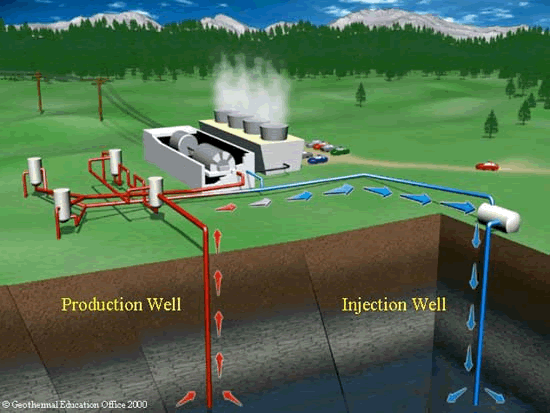
The conventional coal-fired power plant requires the lowest initial investment; however, if regulatory requirements are established, the cost to retrofit this plant with CO2 capture is the most expensive. The IGCC plant has a similar upfront cost as the pulverized coal plant in an unregulated emission scenario; however, IGCC is immature technology and is thus more technically risky and not preferred over pulverized coal plants. However, in a carbon-regulated environment, the conventional IGCC plant is preferred because the cost to retrofit it with CCS technology is significantly less. Lastly, the IGCC plant with a CO2 capture setup requires the largest capital investment; however, with carbon regulations, this plant will be the most prepared to capture CO2 for transport and sequestration.
Another concern for utilities is what to do with existing pulverized coal plants when CO2 emissions are regulated. The options are to replace the plant or retrofit the existing plant with a CO2 capture system. Models have been and continue to be developed to determine the most cost-effective method of deploying a carbon capture and sequestration infrastructure. It has been found that the best return on investment depends heavily on factors including the age of the existing plant, plant operating cost, the regulatory price on CO2, the market cost of the retrofit equipment, and the size of the plant.[xxvi] Therefore, utilities must evaluate their economic constraints for building new plants as well as weigh the benefits of preparing for paying for a price on CO2. Regulatory requirements are likely inevitable, so building plants with CCS in mind is essential.
What Should Policymakers Do?
In a market based economy, consumers have the ultimate say in technology choices. So when products are priced competitively and benefit society, they will be purchased. That does not mean that regulations and taxes don’t have a place in the selection process though; they do. Rebates, taxes, tariffs and regulations all influence costs and value. For many years, our regulators have sheltered oil from its true costs. Lobbyists, big oil and the automotive industry all have had a big say in the deflated cost of oil. Now our environment is paying the price, for food and commodity prices are skyrocketing and the sustainability of the human race is in jeopardy.
Policymakers are essential in ensuring consumers, businesses, and others take steps to protect the environment from anthropogenic emission destruction. By listening to science and making smart decisions concerning the use of our natural resources and then choosing technologies that will minimize the impact on the natural environment, energy prices can be stabilized, air pollution can be improved, and global warming can be mitigated.
Below is a list of policy actions that require serious consideration:
- Carbon Policy – First and foremost, our nation needs to promulgate carbon policy using either a carbon tax or carbon cap and trade market mechanism that will make renewable technologies competitive with conventional energy technologies. It is long overdue that we include, or at least account for, the true costs of pollution and healthcare in the costs of fossil fuels. Logically, this would be a simple switch whereby public healthcare costs, pollution prevention and cleanup would be shifted from standalone taxes and fees to a use or sales tax on all fossil fuels. This should include all combustion and energy use, all transportation use and some or all manufacturing uses.
- Tax Credit Shift – Remove all tax credits from oil production facilities as that only falsely incentivizes oil and penalizes clean energy sources. Award those tax credits to renewable energy project developers.
- Emission Reduction Target Policies – Begin with the end in mind. Require all states to have stringent emission reduction targets. Also ensure those policies allow for market-based flexibility to meet those emission reduction targets.
- Mandatory Energy Efficiency Requirements – Require performance standards on all energy using products and equipment to ensure energy efficiency is continually driven higher and achieved nationally as quickly as possible. California’s Title 24 standards are an excellent source of best practices and should be implemented in all states, mandated by the federal government.
- Energy Efficiency Programs – Enable energy efficiency programs to be managed by the states and regional, unbiased parties (not utilities). This will remove the barriers and unfair competition from entities that are not fuel and technology neutral. Then, each state should have qualified, independent energy consultants and engineers that are also fuel and technology neutral to provide those energy efficiency services. This will allow much faster adoption and more creativity for end user demand management, energy efficiency and on site renewable power solutions at a more cost effective basis.
- Zero Emission Power Plants – No new fossil power plants should be built and all existing plants should be retrofitted for zero emissions. Existing coal plants can be replaced with natural gas combined-cycle plants or retrofitted with CCS technologies to drop CO2 emission levels to zero or negligible output. It is absolutely essential to minimize increasing concentrations of CO2 and other potent greenhouse gases in the atmosphere. CCS is a solution to minimize emissions while renewable technologies are deployed on a large scale.
- Carbon Sink Enhancement – Stop promoting incentivizing use of food crops for fuel. Whatever the United States does, affects all world economies. Carbon sinks need to be enhanced by mitigating destruction of natural carbon sinks such as forests and other vegetated lands.
- Consumer Power Choice – Allow freedom of choice for consumer power. Allow communities to choose their own competitive non polluting sources for energy, whether it be integrated into their own buildings or buying power from a clean power provider. On site power options and rebate programs should not be managed by utilities and power generators. That is a conflict of interest.
- Sustainable, walking/bicycle communities – Stop funding roadway widening of “busy” streets and shift to policies that promote walkable live/work communities so every single resident does not have to drive a car just to get a gallon of milk or a loaf of bread.
- Mass transit – Adopt fast, secure mass transit systems such as light rail in all major cities interconnected to airports and fast bullet trains between the cities. Put an end to policies using food products for fuel. Unfortunately, this only results in pushing up the cost of food commodities which then promotes further acceleration of rain forest clear cutting to grow corn or other crops for fuel. This has an adverse effect of actually accelerated the pace of global warming thus reducing our chances to discover new health care cures as a result of extinction of rain forest plants and animals.[xxvii]
THERE IS NO SILVER BULLET
A hybrid approach to solve the energy crisis is required to ensure our nation has energy security, stabilized energy prices, and a healthy, sustainable future. Aggressive steps by all individuals, business and building owners, utilities and policymakers are essential to ensure the nation continues to invest in these technologies. So, challenge yourself to become educated about one or more of the green energy technologies available to reduce our nation’s energy usage. Use the knowledge you gain to make energy efficient changes in your lifestyle and encourage others to do the same. Communicate with your local, state, and federal representatives challenging them to pass policies that support the development of the technologies that can help green our country.
In summary, the following changes are needed:
- Consumers should walk, cycle or use mass transit to commute and run errands. When that is not available, use only super efficient cars like hybrids or electric vehicles. Consumers should also demand super efficient homes and products. Seek expert advice on how to convert your residence into a zero energy home by improving insulation, shading and efficiency to minimize or eliminate air conditioning, then add solar energy to make up the balance needed.
- Businesses should encourage telecommuting, cycling and mass transit for their employees. Businesses should also get employees and customers involved in energy conservation by promoting awareness and direct cost impacts. Businesses should seek out well qualified architects to design green buildings and engineers to retrofit existing buildings for net zero energy use while building only high efficiency passively conditioned structures.
- Automakers should switch to electric vehicles and invest in development of long lasting, recyclable battery technologies.
- Utilities should invest in sustainable clean generation as close to the demand centers as possible. For example, wind near the Midwest cities and towns, Solar in the Southwest region, nuclear and emerging technologies such as waste-to-energy in the big cities. Existing transmission grids and lines should be upgraded to work at full capacity, full time while enabling intermittent sources easy access to the electric grid.
- Regulators and Policy Makers should transfer all the public air pollution monitoring, control and healthcare costs directly related to fossil fuels as a tax on the fuel. Public utilities commissions should mandate a short term (15 – 20 year) phase in for all fossil fuel power plants to be converted or replaced with zero emission technologies. The IRS should remove all tax credits on fossil fuels and temporarily provide tax credits for building integrated renewable energy systems. State and local officials should mandate that new communities are sustainable and walkable following guidance such as the Ahwahnee Principles. Economic Development officials should work to revitalize downtowns with the same principles, promote walking, cycling and light rail transportation as well as live/work buildings for safer communities and healthier people.
With a common goal of a clean, stable supply of energy, communities, states, and regions can work together to develop and implement policies that are logical for each area. If this is completed, our nation will be able to rapidly develop clean technologies that will save our planet. Act now and mitigate the reign of the fossil fuels![/vc_column_text][vc_column_text disable_pattern=”true” align=”left” margin_bottom=”0″]REFERENCES
[1] The low estimate assumption includes shading, excludes some industrial and agricultural rooftop space, and assumes a 100 W/sq meter output. Please see the Denhol report for the assumptions.
[i] [EIA] Energy Information Administration. “Electric Power Annual 2006.” 2006. http://www.eia.doe.gov/cneaf/electricity/epa/epa_sum.html. (Oct 2007). [ii] [EIA] Annual Energy Review 2007. “Figure 1.5 Energy Consumption and Expenditures Indicators.” http://www.eia.doe.gov/emeu/aer/pdf/pages/sec1_12.pdf (Oct 2008). [iii][EIA]. “International Energy Outlook 2006.” http://www.fypower.org/pdf/EIA_IntlEnergyOutlook(2006).pdf. (Dec 2007). [iv] [EIA]. “International Energy Outlook 2007.” http://www.eia.doe.gov/oiaf/ieo/pdf/0484(2007).pdf. (May 2007).[v] Environmental and Energy Study Institute. “Climate Change Fact Sheet.” http://www.eesi.org/publications/Fact%20Sheets/EC_Fact_Sheets/hansen_climate_testimony_06.pdf. (Apr 2008).
[vi] Energy Information Administration. Annual Energy Review 2007. Energy Consumption by Sector. June 23, 2008. http://www.eia.doe.gov/emeu/aer/consump.html. (September 25, 2008). [vii] [USGBC] United States Green Building Council. “LEED.” http://www.usgbc.org/DisplayPage.aspx?CategoryID=19. (Jul 2008). [viii] Lerner, Eric. The Industrial Physicist. “What’s wrong with the electric grid.” http://www.aip.org/tip/INPHFA/vol-9/iss-5/p8.html. (April 2008).[ix] California State University – Fullerton. “Air Pollution Costs San Joaquin Valley $3 Billion a Year.” March 2006. http://campusapps.fullerton.edu/news/2006/185_airpollutionreport.html (Sep 2008).
[x][NREL] National Renewable Energy Laboratory. “Parabolic Trough Power Plant Market, Economic Assessment and Deployment.” http://www.nrel.gov/csp/troughnet/market_economic_assess.html?print. (April 2008).
[xi] [NREL]. “United States Annual Average Wind Power.” http://rredc.nrel.gov/wind/pubs/atlas/maps/chap2/2-01m.html. (April 10 2008).
[xii] http://www.eia.doe.gov/bookshelf/brochures/epa/epa.html
[xiii]International Nuclear Safety Center. “Maps of Nuclear Power Reactors.” http://www.insc.anl.gov/pwrmaps/map/united_states.html. (April 20 2008).
[xiv] [IPCC] International Panel on Climate Change.
[xv] [DOE] U.S. Department of Energy. “Carbon Sequestration.” http://fossil.energy.gov/sequestration/. (April 2008).
[xvi] New York Times. “More Coal-Fired Power Plants.” http://www.nytimes.com/imagepages/2007/10/19/business/20071020_COAL_GRAPHIC.html. (April 2008).
[xvii] [EIA]. “Emissions of Greenhouse Gases.” http://www.eia.doe.gov/oiaf/1605/archive/gg03rpt/stopics.html. (April 2008).
[xviii]Architecture 2030. “Homepage.” http://www.architecture2030.org/about.php. (April 2008).
[xix] Denhol, P, Ph.D., Robert M. Margolis, Ph.D., and Ken Zweibel.
“Tackling Climate Change in the U.S.” http://www.ases.org/climatechange/toc/05_pv.pdf. (April 2008)
[xx] The California Cars Initiative. “All About Plug-In Hybrids (PHEVs).” http://www.calcars.org/vehicles.html (November 2008)
[xxi][DOE]. “Hydrogen Program Record.” http://www.hydrogen.energy.gov/pdfs/5038_h2_cost_competitive.pdf. (April 2008)
[xxii] [EIA]. “Weekly U.S. Retail Gasoline Prices, Regular Grade.” http://www.eia.doe.gov/oil_gas/petroleum/data_publications/wrgp/mogas_home_page.html. (Jul 2008).
[xxiii] Science Daily. “’Major Discovery’ Primed To Unleash Solar Revolution: Scientists Mimic Essence Of Plants’ Energy Storage System.” http://www.sciencedaily.com/releases/2008/07/080731143345.htm (October 2008).
[xxiv][DOE]. “Annual Report on U.S. Wind Power Installation, Cost, and Performance Trends: 2006.” http://www.nrel.gov/docs/fy07osti/41435.pdf (May 2007).
[xxv][DOE]. “Solar Energy Technologies Program.” http://www1.eere.energy.gov/solar/csp.html. (Dec 2007).
[xxvi] Goliath. “Carbon capture retrofits and the cost of regulatory uncertainty.” http://goliath.ecnext.com/coms2/gi_0199-7309936/Carbon-capture-retrofits-and-the.html. (April 2008).
[xxvii] Time. “The Clean Energy Scam.” April 7, 2008. pg 41 – 45.



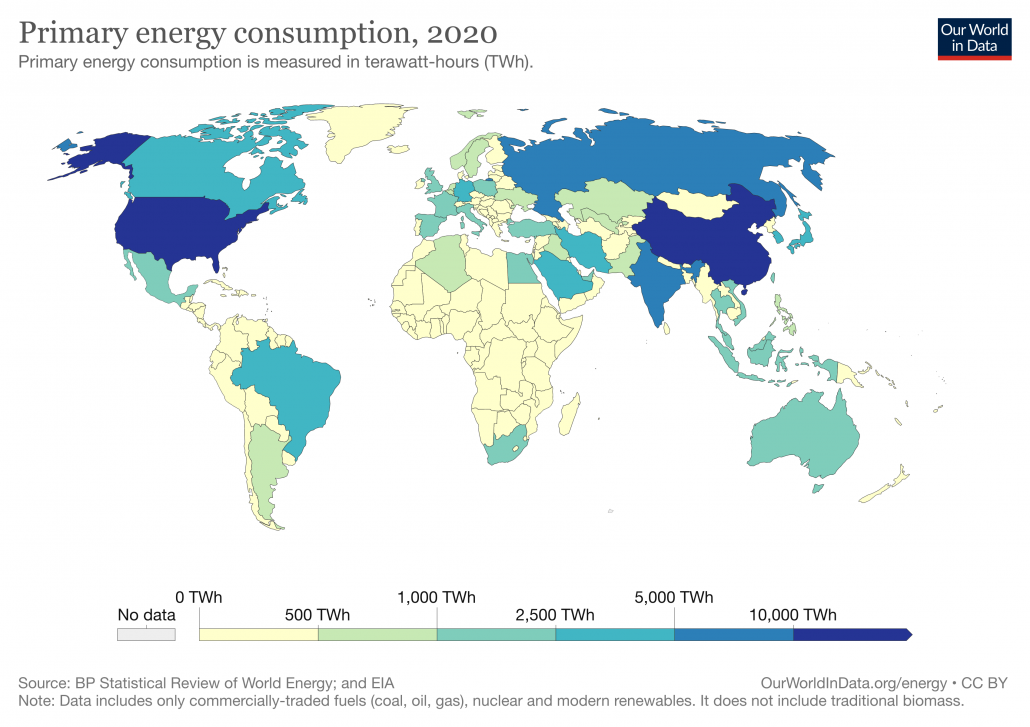
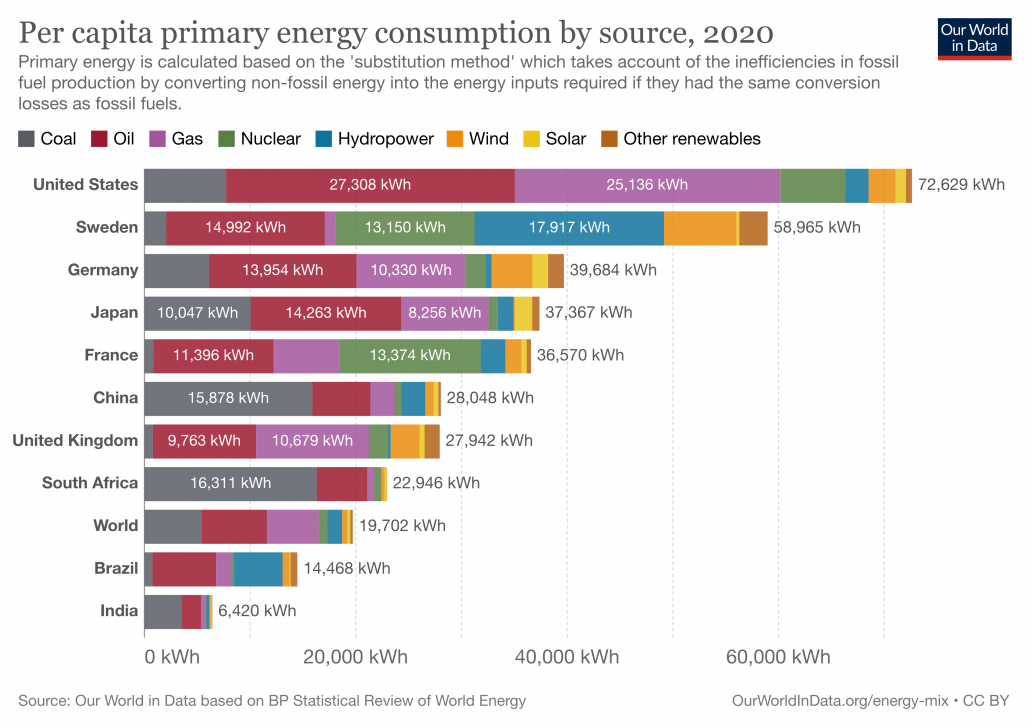
Thanks for the update. Wind is an awesome resource and potentially available 24/7. Add storage and you’ve got a great flexible power source.
I agree with improving mass transit. Trains in Switzerland and Germany are frequent and on time. Perhaps if US was better operated, we’d see much higher ridership? Good point on food for fuels. Using electric vehicles could eliminate the demand for ethanol (corn for fuels) which could free up a lot of US farm land for other crops and the forgotten practice of crop rotation which yields more nutrient dense foods further driving down land waste.